

EPIC database: Britannica Online. National Geographic. Egyptian Life. The Social structure of Ancient Egypt. History - Ancient History in depth: Voices from Ancient Egypt Gallery. Ten Facts About Ancient Egypt. Join us, ancient explorers, as we head 5,000 years back in time to discover fascinating facts about Ancient Egypt, from its ancient beginnings to Egypt today… Facts about Ancient Egypt Read our 10 quick-fire facts on this ancient land, or scroll down to see our modern-day Egypt country profile!
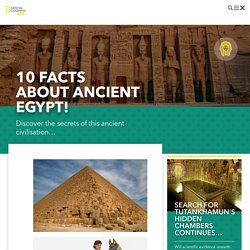
1. Most Ancient Egyptian pyramids were built as tombs for pharaohs (rulers of Ancient Egypt) and their families. To date, over 130 pyramids have been discovered in Egypt. 2. Did you know that we have a FREE downloadable Ancient Egypt primary resource? 3. 4. 5. 6. 7. 8. 9. 10. Country fact file: Egypt today Incredible ancient monuments, scorching deserts and bustling cities – this ancient country is now a sprawling, modern landscape! Egyptian flag OFFICIAL NAME: Arab Republic of EgyptFORM OF GOVERNMENT: RepublicCAPITAL: CairoPOPULATION: 87, 562, 261OFFICIAL LANGUAGE: ArabicMONEY: Egyptian pound, guinayAREA: 1,001,449 square kilometresMAJOR MOUNTAIN RANGES: Eastern HighlandsMAJOR RIVER: Nile?
Egyptian civilization - Daily life - Clothing and adornment. The ancient Egyptians were very particular about cleanliness and personal appearance.
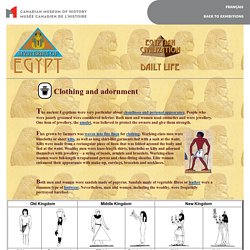
People who were poorly groomed were considered inferior. Both men and women used cosmetics and wore jewellery. One item of jewellery, the amulet, was believed to protect the owners and give them strength. Flax grown by farmers was woven into fine linen for clothing. Working-class men wore loincloths or short kilts, as well as long shirt-like garments tied with a sash at the waist. Both men and women wore sandals made of papyrus. Drawings by John Ide Clothing When royalty, gods and goddesses were portrayed in statues, temple carvings and wall paintings, it was the beauty and self-confidence of the subject that was conveyed. In the Old Kingdom, goddesses and elite women were portrayed wearing a sheath with broad shoulder straps. By the reign of Amenhotep III (1390-1352 B.C.), women's garments were made of very light see-through linen.
The men wore knee-length shirts, loincloths or kilts made of linen. Ancient Egyptian Food and Drink. In Ancient Egypt, the food and drink people consumed depended on the location - a harsh stretch of land in North-Eastern Africa - and the tools and recipes they had already developed.
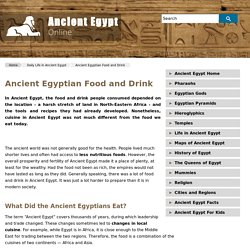
Nonetheless, cuisine in Ancient Egypt was not much different from the food we eat today. The ancient world was not generally good for the health. People lived much shorter lives and often had access to less nutritious foods. However, the overall prosperity and fertility of Ancient Egypt made it a place of plenty, at least for the wealthy. Had the food not been as rich, the empires would not have lasted as long as they did. What Did the Ancient Egyptians Eat? The term “Ancient Egypt” covers thousands of years, during which leadership and trade changed. The most popular menu item in Ancient Egypt was bread. Click here to check out some Ancient Egyptian recipes © Andrej Blagojević - Preserved grains In spite of the vast desert, there was plenty of fertile soil.
. © Ashley Van Haeften - Woman grinding grains. Egyptian civilization - Daily life - Trades and crafts. Stone and clay pots comprise one of the most important categories of Egyptian artifacts.
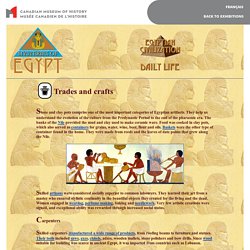
They help us understand the evolution of the culture from the Predynastic Period to the end of the pharaonic era. The banks of the Nile provided the mud and clay used to make ceramic ware. Food was cooked in clay pots, which also served as containers for grains, water, wine, beer, flour and oils. Baskets were the other type of container found in the home. They were made from reeds and the leaves of date palms that grew along the Nile. Skilled artisans were considered socially superior to common labourers. Carpenters Skilled carpenters manufactured a wide range of products, from roofing beams to furniture and statues. Stonemasons and Sculptors Sculptors had to adhere to very strict stylistic rules. Bead Making Brickmakers and potters The word iqdou (Nile mud) was used to designate the profession of the brickmaker and the potter, who used mud from the Nile to make their products.
World History: Ancient Egypt for Kids. Back to History Ancient Egypt was one of the greatest and most powerful civilizations in the history of the world.
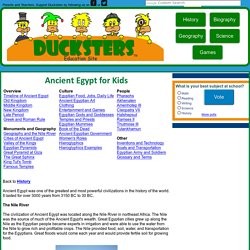
It lasted for over 3000 years from 3150 BC to 30 BC.